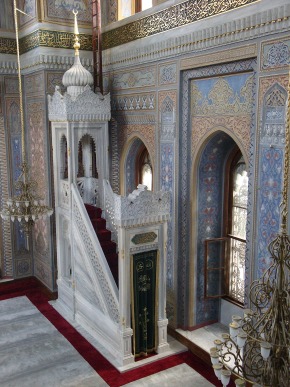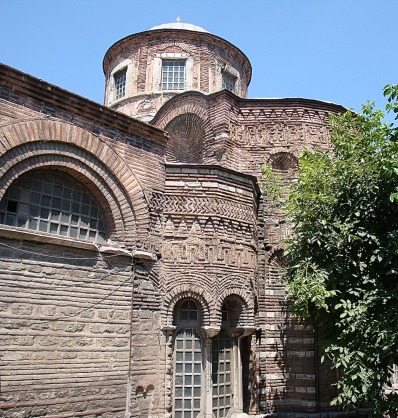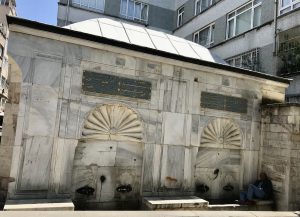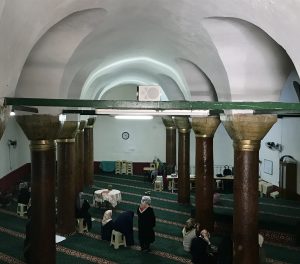“White Palace”
For most visitors to İstanbul Aksaray is the messy transport interchange that they whiz through on the tram on their way to the bus station. The sheer quantity of traffic swilling around here is offputting as is the hectic junction between the tram line and the Metro. It’s here, too, that the road from Laleli divides just beyond the Valide Sultan Cami, with Vatan Caddesi carving out a busy path towards the City Walls at Topkapı while Millet Caddesi heads west towards the walls at Yedikule.
The chaotic traffic set-up makes it impossible to recognise that this was once the Forum Bovis, an immensely important square in old Byzantium where the Mese, the main road that had run all the way up from the imperial palace, split in two just as modern Ordu Caddesi does.
Near the square was the site of a Janissary barracks and, since the Janissaries were partly paid in food, it was the scene of a great deal of meat distribution so that it became known as the Meydan-ı Lahm (Et Meydanı, Meat Square). The square became associated with regular Janissary rebellions so Sultan Mahmud II scrapped the name shortly after abolishing the battalion.
There are several reasons why you might want to spend some time here. The first is the imposing Valide Sultan Cami, beautifully restored and well worth a quick look. The second is the “Little Urfa” collection of restaurants where it’s possible to sample many of the tasty, spicy dishes from distant south-east Turkey. Following the Syrian War, a large number of Syrian refugees came to Aksaray, setting up shops and restaurants with all the flavour of their lost homes.
A quick word on a rather confusing name. Isn’t Aksaray the name of a town in Cappadocia? Well, yes it is except that in the 15th century Sultan Mehmed II’s grand vizier, İşhak Paşa, resettled immigrants from Cappadocia here, hence the name.
 Along Ordu Caddesi
Along Ordu Caddesi
It could hardly have a less impressive setting but the Valide Sultan Cami designed in 1871 for Sultan Abdülaziz’s mother, Pertevnyal Valide Sultan, is nonetheless a striking and impressive building provided you are not the sort of person for whom “real” Ottoman architecture came to a halt in the early 18th century. By the time it was built the idea of enormous complexes to accompany a mosque had gone out of fashion although there is still a school in the queen mother’s name just round the corner on Atatürk Bulvarı that was built just one year later.
There is some uncertainty about the architect behind the mosque; some credit it to Sarkis and Agop Balyan, others to an Italian architect called Montani. Either way, it was built in a baroque style with much frilly decoration around the windows, a smallish dome and two thin minarets. Restoration has given it grey carpeting so that at first glance it looks as if the entire inside is made out of marble, a stunning sight.
Externally, the most striking feature is the long wall incorporating four fountains and a gateway that sits in a dip below the modern pavement.
A little further west a much older mosque tends to go almost completely unnoticed because it’s squeezed onto a triangle of land across which people transferring from the tramway to the Metro tend to rush with their thoughts set on making their connection. Built in 1473, just 20 years after the Conquest, the Murat Paşa Cami boasts an attractive brick-and-stone-striped facade and turns out to be much bigger inside than its exterior might suggest.
Along Vatan Caddesi
The open area immediately behind the Valide Sultan Cami was once the Roman Forum Bovis (Bull Square) but today is just a messy transport intersection that will probably one day be dug up to make a direct link between the tram and the Metro. Along its eastern side, behind an imposing triple fountain, one of the old dervish lodges that were closed down by Atatürk has recently been rebuilt providing the one piece of architectural interest in the area.
As for busy Vatan Caddesi itself, it follows the course of the ancient Lykos stream, long since covered over.
Should you decide to walk west along Vatan Caddesi, you will see the wonderful Byzantine Church of Constantine Lips that became the Fenarı İsa Cami on the northern side of the road. It is one of the oldest religious structures to survive in the city dating back in part to the 10th century.
The original section was built in 907 for a statesman called Constantine Lips and was dedicated to the Immaculate Mother of God (Theotokos Panachrantos). With four chapels on the roof and five apses, it must have been hugely impressive even before a second church, dedicated to St John the Baptist, was built right beside it in the 13th century, adding another three apses, one of which has since been lost. In the 15th century the churches were converted into a dervish lodge. Today they serve as a mosque.
On the southern side of the road is the many-chimneyed Yavuz Sultan Selim Medresesi, designed by Sinan in 1549 and now used as a medical facility. It was Sinan, too, who designed the tomb of Yavuz Sultan Selim’s daughter, Şah Huban Kadın, in 1572. Today it stands ignored beside the car park of the Migros supermarket along with a contemporary school building.
If you divert along Aile Sokak beside the Historia AVM (shopping mall) you’ll pass the elegant Ahmediye (Orta) Çeşmesi commissioned by Damad İbrahim Paşa and come to the Ahmediye Cami. It may not be much to look at but at the back the basement where women pray turns out to be another underground cistern (or conceivably a cellar) dating back to Byzantine times. The mosque was commissioned in 1527 by Maktul İbrahim Paşa for an Orta (battalion) of the Janissaries and so was originally called the Orta or Etmeydanı Cami. However, it was destroyed in 1826 along with the Janissary barracks during the “Auspicious Incident”. Rebuilt in 1913, it was renamed the Ahmediye Cami after Ahmed Fevzi Paşa who had helped to quell the rebellion.
AVM (shopping mall) you’ll pass the elegant Ahmediye (Orta) Çeşmesi commissioned by Damad İbrahim Paşa and come to the Ahmediye Cami. It may not be much to look at but at the back the basement where women pray turns out to be another underground cistern (or conceivably a cellar) dating back to Byzantine times. The mosque was commissioned in 1527 by Maktul İbrahim Paşa for an Orta (battalion) of the Janissaries and so was originally called the Orta or Etmeydanı Cami. However, it was destroyed in 1826 along with the Janissary barracks during the “Auspicious Incident”. Rebuilt in 1913, it was renamed the Ahmediye Cami after Ahmed Fevzi Paşa who had helped to quell the rebellion.
Towards Fatih
If you want to walk north to Fatih from Aksaray the best road to use is Horhor Caddesi which will take you past a turning leading to a seven-storey antiques emporium misleadingly called the Horhor Flea Market. A fountain on the street corner on the right serves as a pointer.
As you pass through the chaos of Aksaray Meydanı (Square) look out for a triple fountain set into the outer wall of the restored Kızıl Minare Cami, said to be the only mosque in İstanbul whose minaret rises from right inside it.
Eating
Akdeniz Hatay Sofrası Renowned for a menu featuring 121 different choices for Sunday brunch, this corner restaurant is a great place to taste chicken or lamb baked in salt although to do so you will need to make a reservation a day ahead. Show up early for the brunch – it really is a banquet that requires plenty of time for appreciation. Ahmediye Caddesi No. 44A, Tel: 0212-531 3333
Has Kral Sofrası A little harder to find that the Akdeniz, the Has Kral also majors on salt-baked chicken and lamb that must be ordered in advance. Ragıp Bey Sokak No. 25, Tel: 0212-534 9707
Kaburgacı Selim Amca Handy branch of “Uncle Selim’s”, a Diyarbakır-born restaurant that serves up delicious stuffed ribs and all sorts of other obscure south-east Turkish treats. Vatan Caddesi No. 61, Tel: 0212-525 1178
Dergah Cafe Advertising itself as a café for language lovers, Dergah is a great and stylish place to chill out over a nargile in a busy part of town. Vatan Caddesi No. 55, Tel: 0212-533 9735
Transport info
There are both tram and Metro stops at Aksaray as well as a tram stop at Yusufpaşa for the Murad Paşa Cami.
Nearby areas
Read more: Strolling Down Army Street


